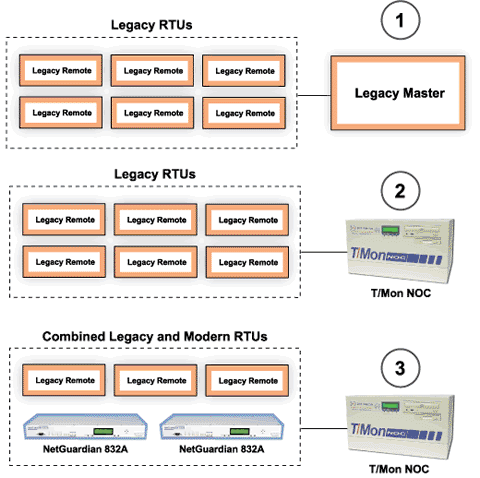Check out our White Paper Series!
A complete library of helpful advice and survival guides for every aspect of system monitoring and control.
1-800-693-0351
Have a specific question? Ask our team of expert engineers and get a specific answer!
Sign up for the next DPS Factory Training!

Whether you're new to our equipment or you've used it for years, DPS factory training is the best way to get more from your monitoring.
Reserve Your Seat TodayThe average life expectancy of an RTU box is the economic life of the unit, or how long it will continue in its original service application. Most people would agree that a "good" system should last a certain amount of time. Each monitoring system or device has a generally established and expected lifespan, and anything that falls short of its life expectancy is usually considered as "poor quality."
However, what should you do when your RTUs run the course of their life, or no longer serve the specific needs they were originally intended to serve? By determining your RTU's lifespan, and what to do with your gear as it nears the end of its life, you can more adequately adjust future expenses.
The end of an RTU's life may occur for many reasons, including obsolescence, poor reliability, expensive maintenance costs, and failure.
The average RTU life expectancy falls between five to ten years. That being said, it's not hard to find quality equipment installed in the 90s, or even the late 80s still in operation.
It's extremely difficult to meet the challenges of managing a telecom network in the 21st century with a monitoring system that was designed in the 1980s. Slow serial connections, proprietary protocols, and obsolete alarm management software have a hard time giving you the best protection for your network reliability.
To be able to meet this challenge, you need our advanced telemetry features, such as after-hours monitoring, email alerts, automatic notification and correction, nuisance alarm filtering and qualification. You're not going to get what you need from your legacy system.
The bottom line is that keeping your network monitoring system longer than its expected life span is not a viable option, for many reasons:
Your legacy monitoring system will break down at any point.
It's just not realistic to keep your network monitoring frozen in 1980s tech.
Your legacy system is probably incompatible with modern network management systems.
How old is your existing remote monitoring and control equipment? Best practices for upgrading include these two simple rules:
If your monitoring system is more than 6 years old, you should at least be planning your upgrade strategies.
If your monitoring system is over 9 years old, you need to contact an expert in remote monitoring immediately to develop your upgrade plan.
Also, it's critical to know at least some of the signs that your aging RTUs are becoming a threat to your network up-time:
They're clunky to operate
Old interfaces just don't compare well to contemporary web browsers. Even veterans have trouble using legacy RTUs, and it's virtually impossible to train new staff when someone retires or otherwise leaves the job.
Your manufacturer is not supportive
Not all vendors offer support for your discontinued RTU, they might charge ridiculous fees, they might even be out of the business completely.
You can't get spare parts
Again, not all vendors can produce any piece of equipment in-house. Most of the companies outsource their components or products from overseas, which might leave you swapping parts from failed units to keep the rest running. What happens when you run out?
Modern RTUs would solve all of these problems. But you can't simply throw out your legacy equipment and purchase brand-new remotes for all your sites.
Despite all the cons of an older alarm monitoring system, many network managers think that they can't possibly afford to replace their legacy equipment - not without a budget-crushing forklift swap out.

There's no point in doing this, though, either financially or technically speaking:
A forklift swap out wastes the original investment in the legacy system.
The capital expenditure of a forklift swap out is more than most companies can absorb in a single budget cycle.
Even if the equipment can be purchased, most companies don't have the installation manpower to immediately deploy them in the field.
A completely new network monitoring system must be installed in phases.
Almost no one has the budget or engineering resources for that, and it's never good to scrap RTUs that are still perfectly functional.
Fortunately, there's a way to transition to contemporary RTUs without throwing away your existing investments.
You can't afford a forklift swap out, you can't simply stay frozen in dead-end old technology, and you can't just wait for a complete system failure to force you into a forklift swap out.
If you're wondering what can be done, know that this is what a solution for your legacy problem should look like:
It must immediately provide a technically stable platform that eliminates the danger of a sudden breakdown.
It must preserve the existing investment in legacy remote telemetry units.
It must not require large immediate costs.
It must be a permanent solution to legacy problems.
It must be a modern system that supports open-ended development, including adding new functionality and new remote telemetry units, and it must be backed by a stable vendor who can commit to long-term support. There's no point in leaving one dead-end legacy system for another.
With controlled migration, so you can gradually move from your existing legacy system to a fully modern network alarm management system.

The solution has two steps:
Replacing the existing legacy master with a multiprotocol master station.
Controlled migration from legacy RTUs to modern remotes.
A modern master is a practical replacement for any legacy master because it can support currently installed legacy remotes. You can get an immediate solution to your most pressing problem - reliability and aging technology - by buying only one unit. The existing legacy RTUs can be maintained in place until the end of their operational life.
Controlled migration puts you, not the vendor, in charge of the pace of migration. You control the cost and schedule of new equipment purchases, the cost of installation transport and manpower, and you also control the sequence of network changeover and its impact on network visibility.
Will efficient RTUs installed today last as long as the legacy ones? The short answer is yes, and probably even longer.
DPS's cost-effective monitoring system design strategy has evolved over the years. We build our equipment in such a way that it continues to be upgradable. We offer free firmware upgrades, so your unit can migrate with the technology as it changes.
The way we, as manufacturers, stand out is that we actually put in practice our architectural principles of allowing integration and interoperability of the units' parts as they change over time. For us, moving forward should be much more fun than it was in the past.

Morgana Siggins
Morgana Siggins is a marketing writer, content creator, and documentation specialist at DPS Telecom. She has created over 200 blog articles and videos sharing her years of experience in the remote monitoring industry.